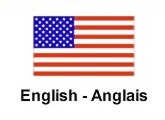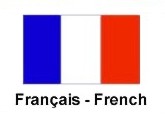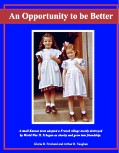Two small villages - Morganville, Kansas and Fèves, France - separated by an ocean and more than 4,000 miles, become
friends because of World War II.
The account in this website is organized as a book and this Table of Contents is the principal navigation tool. Most of
the text is available in English and French. However, the material in the Appendices have not been translated from their
original language.
The story can also be purchased in a hard-cover book, however, items in the Appendices, Trip 2019 and Website Update area
are not included.
A small rural Kansas village seems an unlikely place for anything to happen that might have an effect on the world. But in 1948, it became as famous as the story of "The Wizard of Oz."
These people's contributions were indispensable in securing the needed information and organizing related events.
Hervé Torlotting has been a witness to the rediscovery of this story almost from the beginning and provides a unique perspective.
Those who deserve special mention for their help in documenting this story
When World War II begins, most Americans hope to be insulated from it by oceans to the east and west and friendly neighbors to the north and south. But it is not to be. The destruction during the war of one small village in France captures the attention of an equally-small town in Kansas.
When the war ends, much of the world is suffering. There is a strong desire to do something to prevent another global conflict. Americans are comparatively well off and want to help those in need, while sowing the seeds of a lasting peace.
By 1947, the people in Morganville, Kansas, a prairie village of less than 250 citizens, had made attempts to help people who were victims of the war, but are not satisfied with the results. The Methodist minister, who served in both world wars, prods local Velma Carson to attend a UNESCO meeting in Wichita. What Carson learns results in the adoption of Fèves, France.
After the excitement of choosing Fèves wears off, the citizens of Protestant and dry Morganville begin to wonder if it had been wise to adopt a Catholic village that made wine. But thoughts of innocent, cold and malnourished children override these worries. To raise money, a pageant is planned. As word spreads, everyone wants to be involved.
August 27, 1948, is the big day, with events beginning at 5 p.m. The publicity causes Morganville to swell to eight times its normal size. Of the pageant's many aspects, Carson's play, written in less than two weeks and containing 4,500 words, is the highlight. It tells the village's history, mentions almost every local family and acknowledges the village's limited wealth, yet drives home the idea that Fèves needs help.
The Morganville pageant receives national attention, and at least two radio programs are broadcast to France. The focus in Morganville moves to delivering food, clothing and other aid to Fèves. Wheelchair-bound Homer Christenson delights the children of Fèves by sending candy with help from Operation Democracy's Charles Todd. Letters begin to flow between the sister villages. Wichita, Kansas, inspired by Morganville, adopts Orléans, France. Todd and Ségolène de Wendel, a representative of Lorraine, France, visit Morganville. Morganville native Billie (Pierson) Utley and husband Ed, living in Paris, make a trip to Fèves.
With Fèves recovering, it produces a "thank-you" program involving many local and national officials. The villages agree that they should change roles from aid recipient and benefactor to being friends. Two unique gifts are exchanged as a symbol of this change in their relationship. Morganville farmer August Kolling had not been a supporter of the adoption of Fèves, but his visit to the French village changes his mind.
Minister Elmore McKee features the sister-city connection in an international radio broadcast in 1950 and a book in 1955. But the language difficulty remains a major hurdle for the two villages. So with France well on the road to recovery, the start of the Korean War, and widespread fear in the United States over the threats of communism and nuclear war, the connection between the villages fades. Clay County Historical Society museum curator Cathy Haney preserves remnants of both the pageant and sister-city connection. In 1993, she attempts to revive interest with a public program.
A flood in 1951 combines with a college class assignment in 2013 to again bring public attention to the connection between Morganville and Fèves. It culminates in two of the 1949 aid recipients visiting their benefactor.
In 2014, acting as ambassadors from Morganville, Freeland and Vaughan visit Fèves and are greeted with two receptions and a tour. In 2015, a contingent from France calls on Morganville and the following year, the Morganville mayor and his wife visit Morganville's sister city. In the summer of 2019, the sister-city relationship brings 11 Americans to Lorraine.
The previous 10 chapters relate the details of the Morganville-Fèves story, including the circumstances that formed the basis for the connection. But facts and events only convey so much. McKee attempted to give meaning to the story with comments such as "... Morganville, like so many other small towns, had taken America's idealism to its heart and reached out to help bind up the wounds of Europe." The authors offer a modern and more extensive assessment of the pairing of the sister cities.
These people played important roles in the connection or reconnection of the sister cities.
Brief biographies of the authors
A collection of materials which did not fit neatly into THE STORY, but expands on aspects of the tale.
Sources - letters, personal documents, photos, books, newspapers, magazines, websites - consulted during researching. Many are cited within the text.
The source for an image and/or graphic.
A group interested in the story visited France in June 2019. These pages include a daily log, who the visitors were and related details.
An alphabetized listing of topics referenced in the text. It does not include items in the Appendices, Selected Sources or Trip 2019.
Chronology of website changes allowing a visitor to determine if a change had been made since a previous visit.


